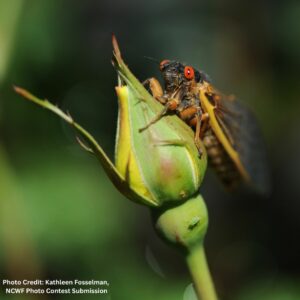Catch The Buzz – Cicadas and the Wild Phenomenon of Dual Emergence

It would be easy to believe that they originated from a distant planet, boasting robust and armored bodies, glistening eyes ranging from crimson to ebony, wings reminiscent of a character from a sci-fi film, and a call that rivals the decibel output of motorcycles.
 However, these species did not arrive from outer space. These insects – cicadas – emerge directly from the ground beneath our feet. And remarkably, towards the end of April, they will surface in extraordinary numbers for the first time since 1803.
However, these species did not arrive from outer space. These insects – cicadas – emerge directly from the ground beneath our feet. And remarkably, towards the end of April, they will surface in extraordinary numbers for the first time since 1803.
Two cicada groups, Brood XIX (the Great Southern Brood) and Brood XIII (the Northern Illinois Brood), are set to participate in what’s termed a “dual emergence,” synchronizing their cycles to emerge simultaneously.
While it’s not unusual for two cicada broods to emerge concurrently on a single continent, it’s exceptionally rare for them to do so in overlapping geographic regions, encompassing vast swathes of the southeastern United States and stretching up into Illinois, Iowa, and southern Wisconsin.
Although it’s difficult to predict the extent of this emergence, estimates suggest it will be in the trillions, similar to the last comparable event where people were reported to clear hundreds of dead cicadas from their driveways.
While this phenomenon might sound startling, it poses no real dangers and stands as a remarkable testament to the captivating ways of wildlife.
But to fully understand just how unique this event will be, we should dive into what cicadas are and how they function. And there’s no better time than April, during NCWF’s Wildlife in the Overstory.
What Are Cicadas?
Cicadas are large insects in the superfamily Cicadoidea, which is divided into two families of cicada, Tettigarctidae and Cicadidae.

A freshly emerged cicada on top of its molted shell.
Cicadas are herbivorous insects that exclusively consume liquid sap generated by woody plants. They get this sap by creating a small incision in the bark and utilizing their specialized mouthparts to draw the sap from the inner xylem. As opportunistic feeders, cicadas will consume sap from various species of trees and shrubs.
The size of cicadas varies among species, typically falling within the range of one to two inches. While their compound eyes are their most prominent facial feature, they also possess three smaller simple eyes called ocelli, positioned between the compound eyes in a triangular arrangement at the front of the head.
Attached to the thorax and folded over the abdomen are four layered wings—two larger wings with two smaller ones beneath. These wings have a coating of microscopic waxy structures called nanopillars, serving as armor, camouflage, waterproofing, and bacterial protection. The densely clustered nanopillars repel droplets of rainwater or dew, facilitating the removal of dust and debris from the wing’s surface. These nanopillars also create an unfavorable environment for bacteria, rupturing bacterial cell membranes upon contact with the wings. Additionally, the nanopillars absorb light, minimizing reflective surfaces and reducing the likelihood of attracting predators.
When folded, the wings shield the reproductive organs situated in the abdomen of female cicadas. However, the male abdomen is largely hollow and serves as a resonating chamber to amplify their distinctive vocalizations.
Cicada Reproduction

Undoubtedly, the call of cicadas is a familiar sound to most people, whether or not they recognize its source. Ma
le cicadas produce a distinctive, robust rasping noise using a membrane on their abdomen called the tymbal organ, designed to attract female mates. This resonant call results from the rapid contraction of the tymbal organ, pulsating at a rate of 120 to 480 times per second and resonating through the male’s abdominal chamber. Reaching volumes exceeding 100 decibels, it is as loud as an average car horn.
Following mating, a female cicada will cut a slit into the bark of a tree to deposit her eggs against the xylem. Upon hatching, the juvenile nymphs fall to the forest floor and burrow into the soil, sometimes reaching depths of up to eight feet. The length of time spent underground varies depending on the species; while many cicadas spend 2-5 years below the surface, certain species, such as those belonging to the North American genus Magicicada — comprising the Great Southern Brood and the Northern Illinois Brood previously mentioned — remain dormant for 13 and 17 years, respectively. These prolonged periods underground before a mass emergence are likely a strategic evolutionary adaptation to evade predators. Spending extended periods underground makes them an

An empty cicada molt.
unreliable food source for predators, and their synchronized emergence diminishes the potential for predators to deplete the population,
leading to a phenomenon known as “predator satiation”, ensuring ample cicadas survive to reproduce and perpetuate their species.
During their time underground, cicada nymphs develop robust front legs, allowing them to excavate soil and penetrate tree roots, from which they extract sap to fuel their development toward adulthood. In moist environments, cicada nymphs construct mud mounds on the soil surface to cleanse and aerate their underground burrows.
When the time comes to surface, nymphs tunnel upward, ascend a nearby tree or shrub, and undergo their final molt, emerging as fully developed adult cicadas. The discarded nymphal exoskeletons are frequently observed clinging to the bark of trees in wooded areas during the early summer months.
Want to learn more about Wildlife in the Overstory?
Written by:

– Bates Whitaker, NCWF Communications & Marketing Manager

– Dr. Liz Rutledge, NCWF Director of Wildlife Resources



